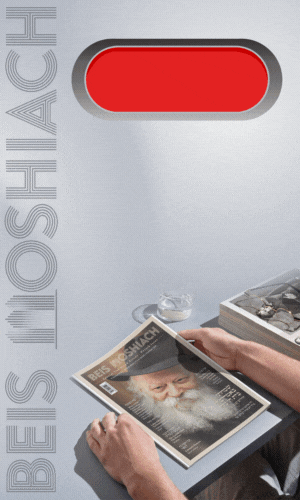Don’t Just ‘Wait And See’ – Open Your Eyes Now
When Moshe came down after the the calf’s sin was forgiven, a new system began. The system of Torah study. Moshe taught the people in groups, each group learning directly from him. Why did Moshe do this? Wasn’t it a waste of time? Shouldn’t it be enough to teach one group and they can then teach the rest of the nation? • Full Article
DON’T JUST ‘WAIT AND SEE’ – OPEN YOUR EYES NOW
BEGIN WITH GRIN
A plane flew over the quiet Atlantic, far from land. Suddenly, the pilot is heard over the sound system.
“This is your pilot speaking. I have good news and bad news. The bad news is that the plane’s engines have stalled out, we are diving and I’m trying to make an emergency landing. The good news is that we are near a small island, far from civilization, where we can live the rest of our lives since nobody will find us.”
The plane makes a perfect emergency landing on the island. Among the passengers are a frum couple from Bnei Brak. The wife asks her husband, “What will we do? There’s no shul, no kosher food and we’re stuck here…”
Her husband says, “Did you give the check that you promised the yeshiva in Bnei Brak?”
“No,” says his wife. “I didn’t get to it because of our preparations before the trip.”
The husband smiles and asks, “Did you pay what you promised the shul?”
“No,” says the confused and somewhat irritated wife. “What does this have to do with anything?”
The husband’s smile turns into a chuckle. “And did you renew the direct deposit for tuition to our son’s yeshiva which expired?”
“What’s the matter with you? No, I didn’t renew it.”
“Then, don’t worry,” says the husband laughing. “They’ll find us…”
SEEING IS BELIEVING
Most of parshas Ki Sisa has to do with the Cheit HaEgel (Sin of the Golden Calf) and its atonement. When Moshe came down from the mountain for the last time, on Yom Kippur, 10 Tishrei of that year, a new way of life began for the Jewish people, a system of Torah learning, from master to student, as Moshe learned and taught Aharon and his sons, the elders of Israel, and the entire nation.
“And it was when Moshe descended Mt. Sinai… and Moshe called to them, and Aharon and all the Princes of the congregation returned to him and Moshe would speak to them and afterward, all the children of Israel would draw near and he would command them everything that G-d spoke to him on Mt. Sinai.”
The Gemara (Eiruvin 54b) teaches us the order, the hierarchy of learning in those days. “The Rabbis taught: What was the order of teaching? Moses would learn from the mouth of the Almighty. Aharon would enter, and Moshe would teach him his chapter. Aharon would move away and sit at Moshe’s left. His [Aharon’s] sons would enter, and Moshe would teach them their chapter. They would move away, and Elozor would sit at Moshe’s right and Isamar would sit at Aharon’s left. [Then] the elders would enter, and Moshe would teach them their chapter. The elders would move away and sit down on the sides. [Then] the entire nation would enter, and Moshe would teach them their chapter.”
Have you heard of a teacher who teaches the same thing four times?! Wasn’t this a waste of Moshe’s time?
The Gemara finds this difficult too. The Gemara asks why Moshe taught it four times. It should have been possible that after Aharon learned from Moshe, Aharon would teach his sons, and they would teach the elders, and the elders the rest of the Jewish people. The Gemara’s answer is not surprising, “Since Moshe learned from the ‘mouth of the Almighty’ his teaching was effective.” Chassidicly understood, this means that Torah study is not the transmission of information. Torah study is a bond between the G-dly soul and its Creator, a bond with G-d. The Jewish people needed a connecting-intermediary between them and G-d – Moshe Rabeinu. He was able to receive the word of G-d directly and transmit it directly to the souls in physical bodies in this world, because learning Torah from Moshe is like learning Torah from G-d Himself.
What is the significance of learning Torah from Moshe for us today, thousands of years after the transmission of Torah has changed so greatly? And what does this teach us about the true and complete Geula?
In order to answer this, we need to focus on and delve into that special way of learning, from Moshe himself. At the beginning of parshas Vaeschanan, Moshe declares to Hashem, “You began to show Your servant.” In Chassidus (Likutei Torah) it explains that this is meant to hint that Moshe merited the aspect of “vision.” He did not only hear Torah and the revelation of G-dliness; he saw and sensed it with eyes of flesh. This began back at Mattan Torah, when “face to face did G-d speak with you,” but the rest of the Jewish people couldn’t bear this wondrous revelation and that’s why their souls flew out, unlike Moshe who attained the level of “Your servant,” who could see and remain alive. And it is this seeing which he had to convey to his audience, the rest of the Jewish people. Moshe himself taught those sitting before him in the same way that he learned – on the level of seeing!
This is precisely the reason that nobody could replace him. This is what the Gemara means, “his teaching was effective.” Since Moshe learned from G-d in a way of seeing, only he can transmit things in a way of seeing! Learning Torah from Aharon and his sons is definitely an unforgettable experience, and so too, learning Torah from the seventy elders, but that’s about conveying information, not vision.
SEE WITH YOUR MIND’S EYE
That’s all well and good but as always, good things come to an end. Even learning Torah in a way of palpable vision had an end. The experience that the Jewish people of feeling had, like they were learning Torah directly from G-d had an end. This level was only for the generation of the desert, souls from another world, the generation that got to see the Shechina at the sea and at Mattan Torah, a generation that lived miraculously, ate bread from the heavens, and was not involved in mundane life.
But the generation that entered the land (and subsequent generations), were lower souls that had to work with the material aspect of the world; with the sweat of your brow shall you eat bread. These generations which cannot relate to such a lofty level of Torah study, experience a revelation of G-dliness only through hearing, through intellectual understanding and insights that prove the existence of the G-dly reality.
We’ve already spoken many times about the difference between seeing and hearing in spiritual terms. In plain words we can say: When learning from Moshe, the understanding of Torah was on a level that is indescribable. Their grasp of Torah was tangible, and their connection with G-d, the Giver of the Torah, was an experience of absolute truth.
Just as it was with the generation of the desert, so too will it be with the generation of the Geula. The Geula state of existence will be a state of seeing and apprehending the absolute truth of G-d and G-dliness. First of all, the curtain will be removed and the false presentation of physical reality which appears to live and exist on its own, will end. Our physical eyes will open and we will see Hashem Himself, a level which even Moshe did not merit as he was told, “man cannot see Me and live.” This seeing will extend itself to Torah study as well. Vision will turn abstract reasoning into obvious perceptions. High levels of G-dliness will turn into understandable reality. The effect of learning in a visual way will impact the very being of a person and even the physical body, as part of a total experience. This manner of learning also makes it possible to teach the entire Jewish people simultaneously.
The disadvantage of hearing is the need to use words appropriate for the level of every listener. With vision, on the other hand, there’s no need for excessive verbiage. Presenting things in a visual manner is something grasped by all, from the greatest of the great to the smallest of the small, simultaneously.
As for us, although it says in Chassidus that Moshe wanted to implant this wondrous spiritual level in all Jewish souls throughout the generations, he was unsuccessful. Therefore, at the end of his life, it says about him, “He saw the first [portion] for himself,” i.e. the way of learning through seeing was unique to and only for “himself.” As for the rest of the Jewish people it says, “And now Yisrael, listen…” Now, before Moshiach’s coming and the Geula, the rest of Israel are not on the level of seeing, and therefore all they can do is just hear.
In any case, the Rebbe teaches us that we need to taste the promises of the Geula even before the Geula, like tasting the Shabbos food before the onset of Shabbos. So too with learning Torah as a preparation for the Geula, although we still haven’t merited “seeing,” we need to try to internalize our Torah study as though we see; not to learn superficially, daf after daf, maamar after maamar, without putting one’s heart and neshama into the learning. One needs to (try and) see things, to internalize the concepts, to feel closeness to the divine, and thus merit, “and our eyes will see when You return to Tziyon with mercy.”
TO CONCLUDE WITH A STORY
We will end with a story about one of the great students of the Maggid, ‘the Volper.’ In Beis Rebbi it says about Rabbi Chaim Volper “that from the start, he was the greatest of the fellowship and everyone went to hear the Torah of the Maggid from him, for he would review it as it was said and with good flavor.” In Toras Sholom it says, “Of the students of the Maggid there were two who received the Maggid’s entire Torah. R’ Shlomo of Karlin would become ill [when the Maggid would say Torah] with bloody excretions, the rav from Berditchev would go out of ‘his vessels’ with intense dveikus and excitement, and only Rabeinu HaGadol the Baal Ha’Tanya and the rav of Volper received.”
At the end of his life, the Volper became an alcoholic and he would go around begging as he wandered from village to village. He once went to the Alter Rebbe as the latter said a maamar. He listened and at the end he said, “We all ate from one bowl but he took the best part.”
It’s told that Rabbi Boruch Mordechai [Ettinger] of Bobroisk met him at an inn and when the Volper left his belongings for a moment, the Chassid began searching through them, hoping to find some writings of the Maggid. When the Volper caught him in the act, he said: “To you, the Rebbe and the Torah are separate things, and Chassidim are separate. Therefore, you need the writings, but to us, the Rebbe, the Torah and the Chassidim are one thing.”
This is how we ought to learn Torah!
Good Shabbos!
*
Moshiach Beparsha is a weekly drasha connecting the Rebbe’s teachings on Moshiach with the weekly Parsha, presented in an engaging way with stories and practical life lessons.
Hebrew – chat.whatsapp.com/I8x3Ad4QbNvCJLZGB7scVM
English – chat.whatsapp.com/LGkyDS6tQKzBfy0NZE3zXU
Russian – chat.whatsapp.com/JZ2iVmClpe3LJaKtVgRc4M
French – chat.whatsapp.com/GoeJrGDsSQAAtu1jh7MfBY
27
Join ChabadInfo's News Roundup and alerts for the HOTTEST Chabad news and updates!











































